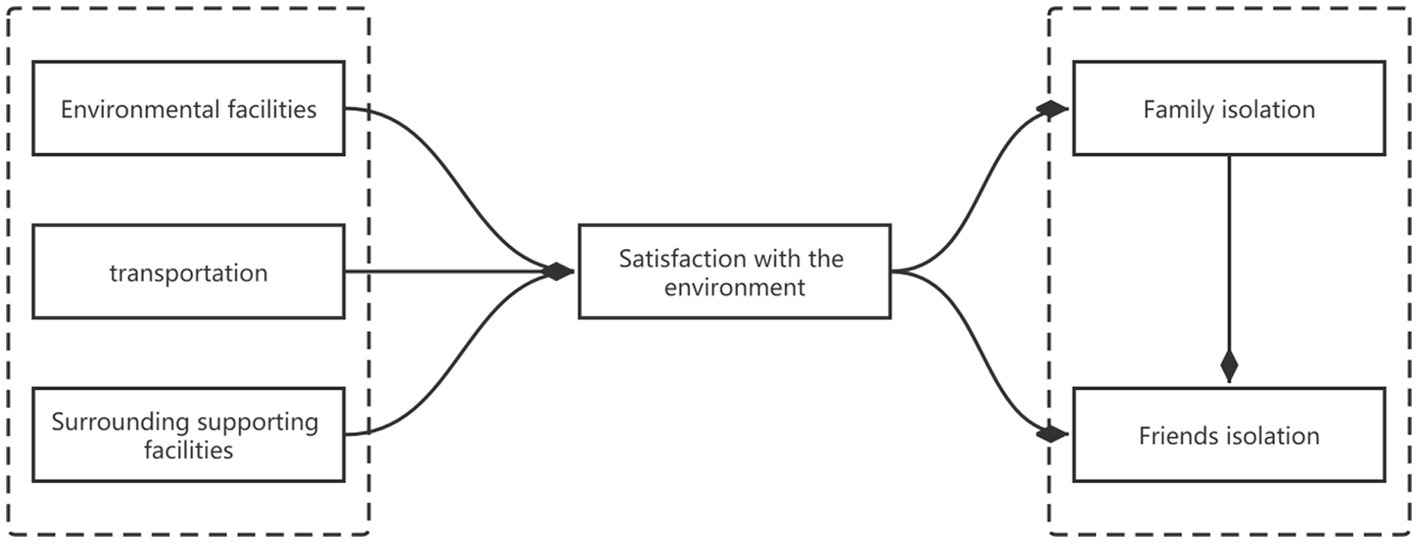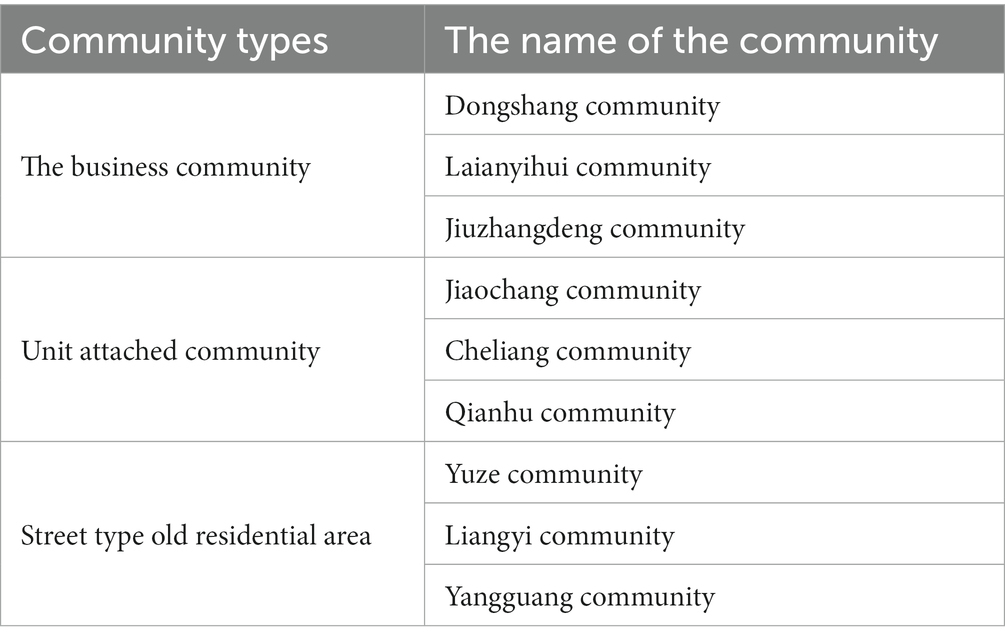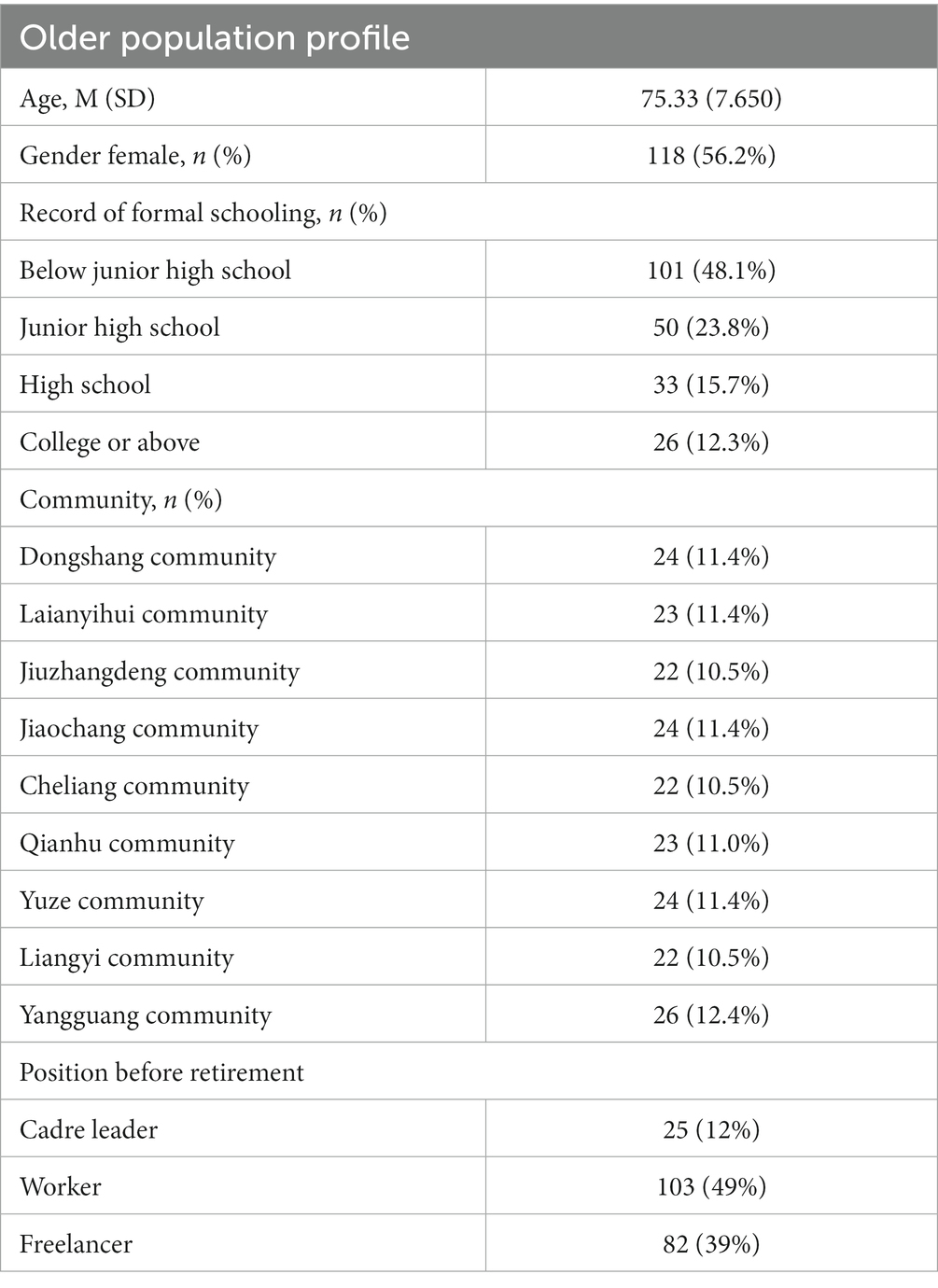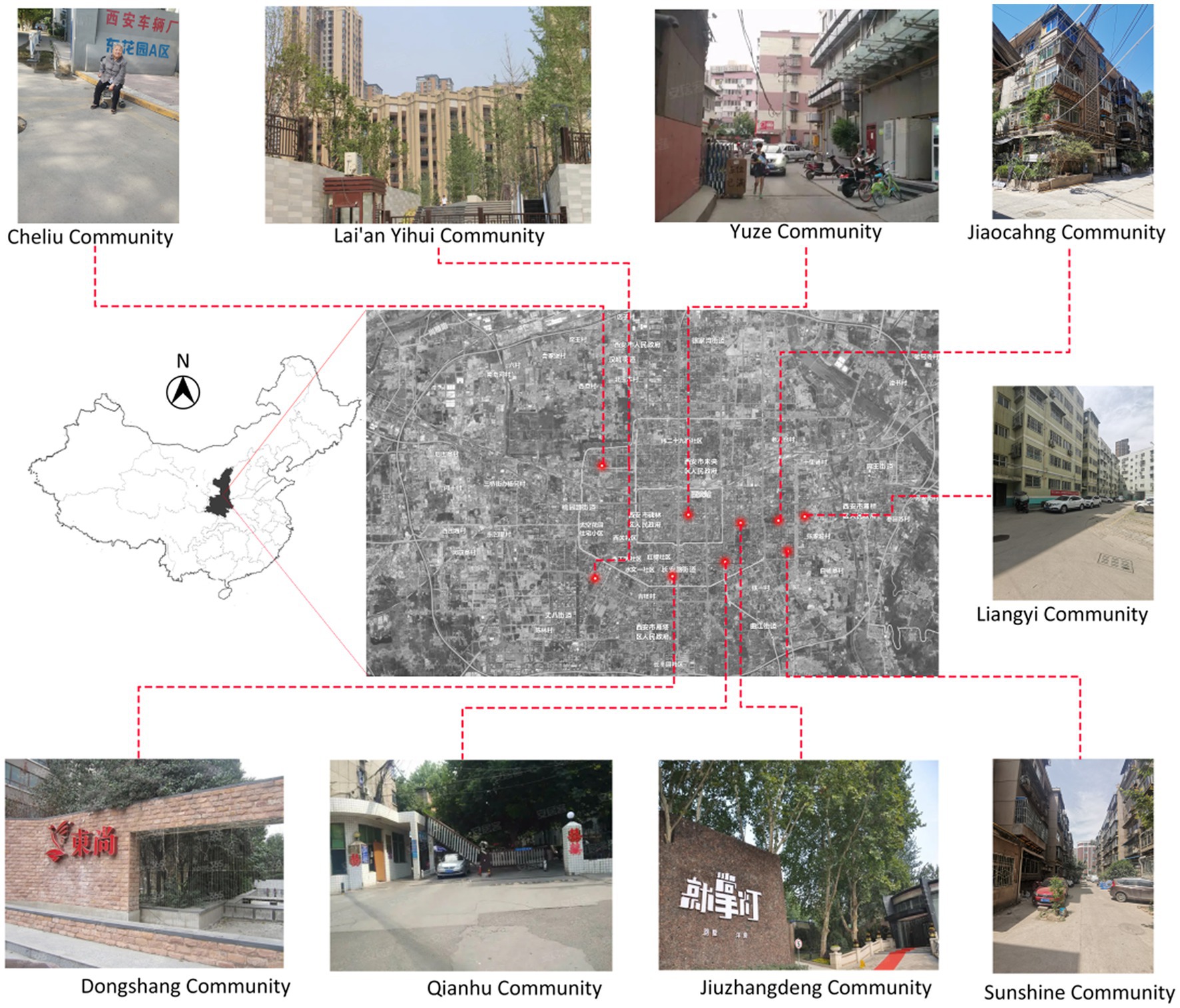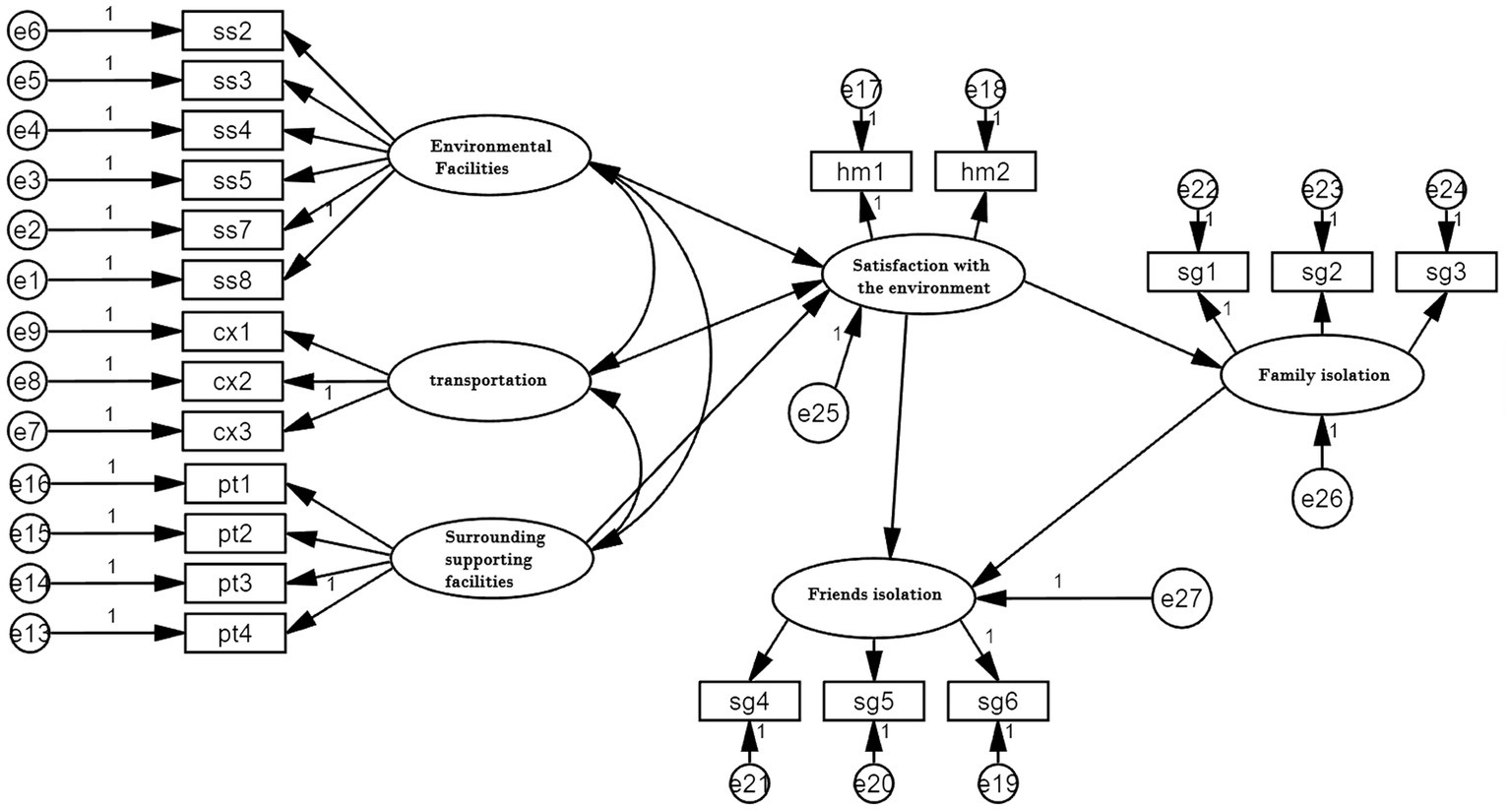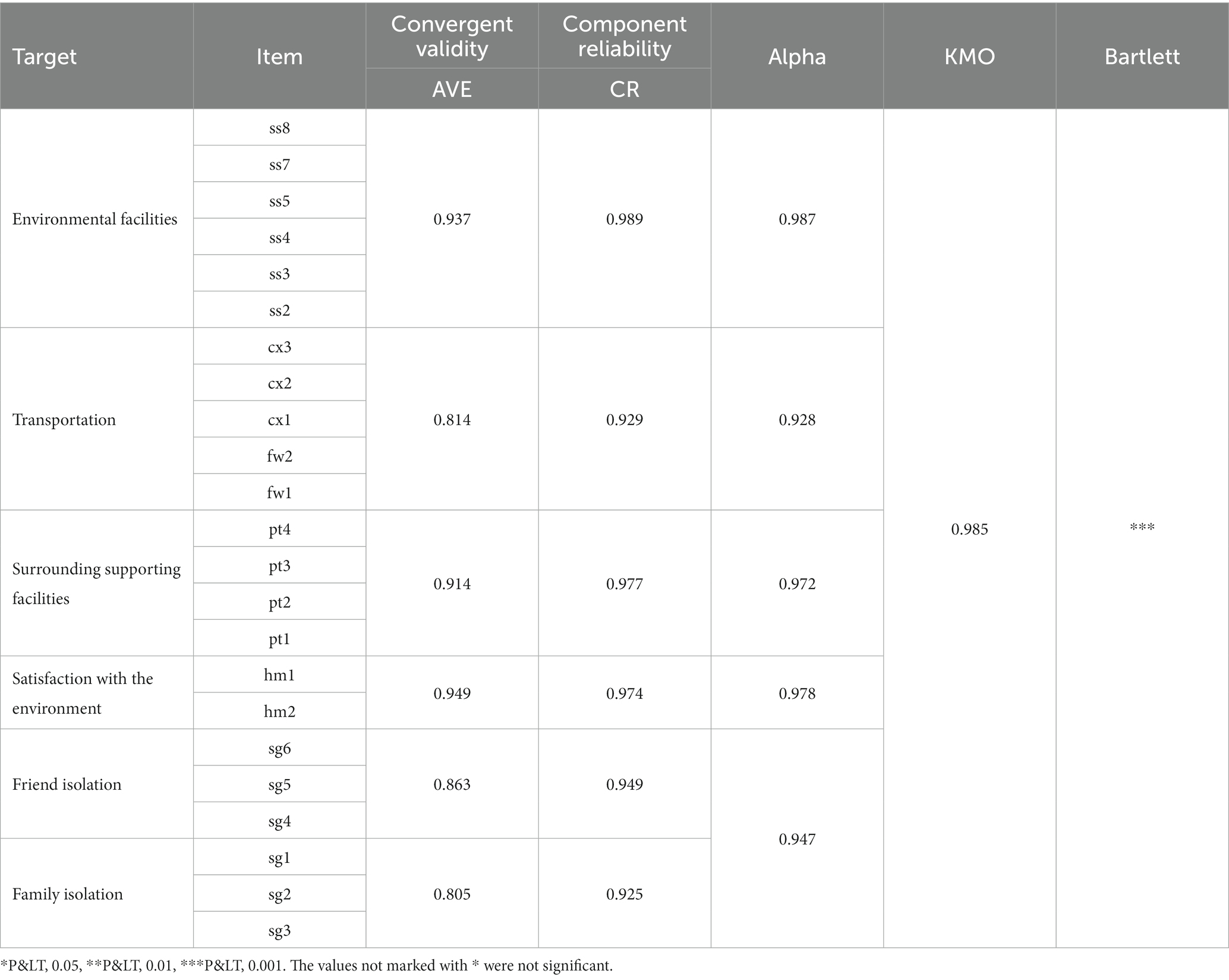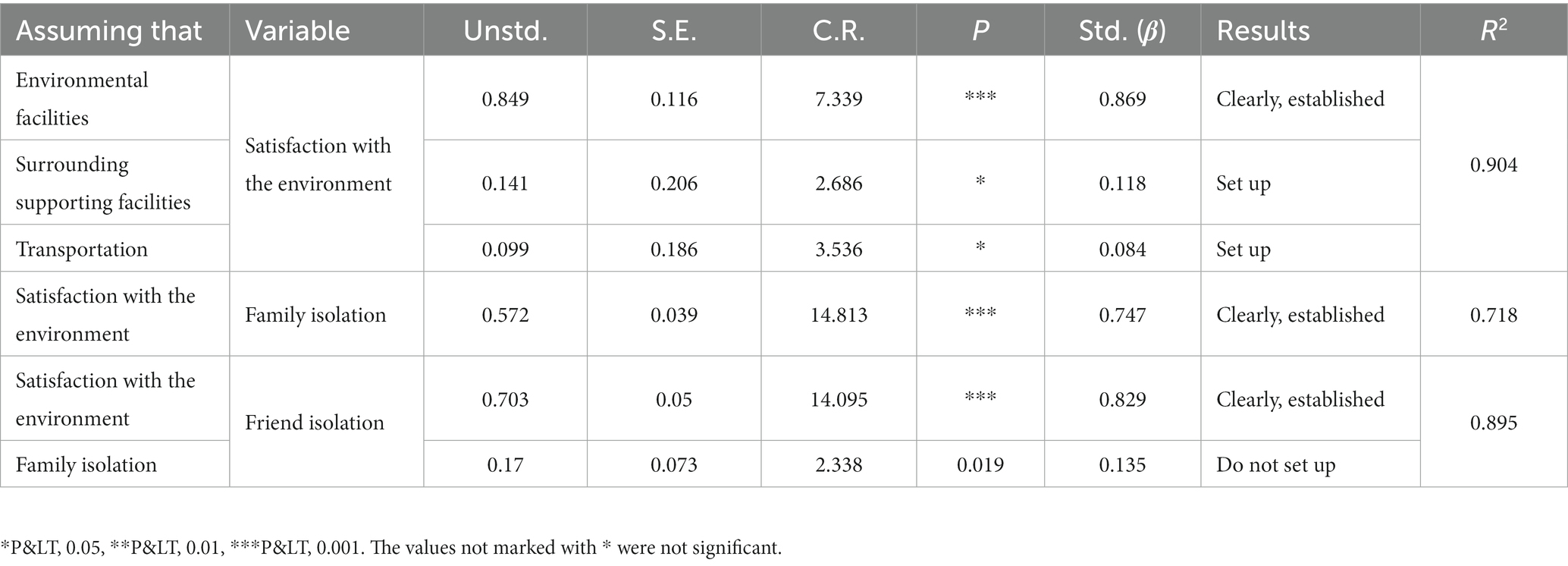- 1College of Landscape Architecture and Arts, Northwest A&F University, Xianyang, China
- 2College of Architecture, Chang’an University, Xi’an, China
Background: To explore how to prevent the social isolation of the older adult, this study constructed a model of the influence of community environmental satisfaction on the social isolation of the older adult from the three dimensions of environmental facilities, transportation, and supporting facilities around the community. Methods: The social network scale and environmental satisfaction scale were used to collect the sample data of nine communities in Xi’an, and the maximum likelihood estimation method was used to analyze the data and test the model.
Results: (1) Environmental facilities, transportation, and community surrounding facilities promoted community environment satisfaction (R2 = 0.904). Among them, environmental facilities (β = 0.869) had the greatest impact on community environmental satisfaction, followed by transportation (β = 0.118), and surrounding facilities (β = 0.084) had the least impact on community environmental satisfaction. (2) Environmental satisfaction had a direct positive impact on social isolation. Among them, the impact of environmental satisfaction on friend isolation (R2 = 0.895, β = 0.829) was greater than that on family isolation (R2 = 0.718, β = 0.747).
Conclusion: Environmental satisfaction can directly affect the social isolation of the older adult in the community and can be used as an intermediate variable of environmental facilities, transportation, and surrounding facilities in the community so that it can indirectly affect the social isolation of the older adult. The results of this study provide a scientific basis for the design of aging environments in the future.
1. Introduction
China’s aging problem is becoming increasingly serious. According to the latest census results of China, the number of people over 60 years old has reached 264.02 million, accounting for 18.70% of the total population (1). Research finds that most of the older adult in the community have lost their social participation and social interaction after retiring (2). American sociologist Burgess called this situation social isolation (3); that is, “people are passively or actively derailed from society, and their social interaction, interpersonal communication, activity participation and other communications are in isolation” (4). Studies on the consequences of social isolation and harm have conducted sufficient scientific research, but the research on preventing social isolation is limited (5). Therefore, the effect of community environment satisfaction on helping the older adult take the initiative to communicate, exercise, and travel is unknown. The prevention of social isolation requires further exploration.
1.1. Effects of social isolation
Social isolation has a serious impact on the quality of life of the older adult (6–8) and increases their sense of loneliness and produces a variety of negative emotions, thus causing a series of diseases, such as depression (9), stroke (10), and senile dementia (11). Long-term social isolation can even lead to extreme behaviors such as suicide (12). On the other hand, the health of the older adult directly influences their social isolation (13, 14), and a lack of exercise makes the older adult more prone to social isolation (15). Family factors can also produce social isolation in older people. Currently, the social isolation conditions of the older adult worldwide are not optimistic, and attention needs to be given to various social aspects.
1.2. Community environment satisfaction
The physical function of the older adult gradually declines with age, and the community and its surrounding space become the preferred place for the older adult to engage in activities and have social interactions. People are no longer limited to meeting through the daily use of the community environment but have begun to pursue other features. For example, Anthony Barnett et al. Claimed that the community environment and neighborhood relations has a great impact on the physical and mental health of the older adult (16). A good natural ecological environment in the community has a certain rehabilitation effect on the psychological and physiological health of the older adult (17). The evaluation of the quality of the community environment depends on people’s satisfaction with the community environment, among which community recreational facilities, healthcare facilities, and so on are important factors of community satisfaction (18).
Initial indicators were obtained through interviews with the target population and bibliometric analysis of CiteSpace. Combined with expert opinions, three indicators of environmental satisfaction were finally determined, namely, community environmental facilities, transportation, and supporting facilities around the community. On the basis of community satisfaction, the satisfaction index related to living was eliminated, and only the satisfaction index related to the outdoor activity space of community residents was targeted. Such indicators are more conducive to exploring the relationship between the community environment and social isolation.
1.3. Research hypothesis and model
A structural equation model can solve many problems that cannot be directly observed and deal with the causal relationships between some fuzzy variables and multiple variables at the same time, making up for the shortcomings of traditional statistical methods (19). However, no study has used structural equation modeling to discuss the social isolation of the community environment and community older people. Based on this, this study identifies and analyzes the influencing factors of community environmental satisfaction and social isolation from the perspective of the community environment. In addition, a structural equation model, such as Figure 1, is constructed by taking environmental facilities, transportation, and supporting facilities as independent variables, environmental satisfaction as an intermediary variable, and family isolation and friend isolation as dependent variables. Based on the above discussion, the following hypotheses are proposed:
H1. The facilities surrounding the community have a positive impact on the environmental satisfaction of the community.
H2. Community transportation has a positive impact on community environmental satisfaction.
H3. Community environmental facilities have a positive impact on community environmental satisfaction.
H4. Environmental satisfaction has a positive impact on family isolation.
H5. Environmental satisfaction positively impacts friend isolation.
H6. Family isolation has a positive impact on friend isolation.
2. Materials and methods
2.1. The study area
The study was conducted in Xi’an, the capital of China’s Shaanxi province, with a total population of 12.6 million. According to the seventh census data, the older adult over 60 years old accounted for 16.02% of the city’s permanent population, an increase of 3.48 percentage points since 2010 (20). The population density of the older adult also shows that the aging speed is accelerating in Xi’an (21). This study selected three types of communities that contain mostly older adult residents from the three typical communities in the questionnaire (Table 1) (22). Among them, nine communities significantly differed in terms of the internal spatial structure, surrounding environment, and business environment. This allows a more comprehensive exploration of the problems related to the relationship between environmental and social isolation of older adult people in Xi’an to avoid data limitations.
2.2. The research methods
The research questionnaire was divided into three parts according to the research objectives:
1. The general information scale measured gender, education level, age, marital status, monthly income, household registration, physical health status, etc.
2. The social isolation survey scale was the Lubben Social Network Scale, LSNS-6 (23) (a total of six items, three items for each dimension).
3. The environmental satisfaction scale contains 22 items, including 4 items on environmental satisfaction, with 8 questions in the environmental facilities dimension, 3 questions in the supporting facilities dimension, 3 questions in the transportation dimension, and 3 questions in the community service dimension.
The environmental satisfaction questionnaire and the social isolation questionnaire used a 7-point Likert scale (24, 25) (each item was assigned 1–7 points, with 7 points indicating “highly approve” and 1 point indicating “highly disapprove”; some items were trap questions, and such questions were revere scored).
2.3. Data collection
The survey period was from March to May 2022, and the participants were residents aged ≥60 years old, in good health, with autonomy and cognitive ability from the above nine communities. The questionnaire was administered during random interviews in the community. To ensure the accuracy of the survey data, the author explained the questionnaire to the participants individually to ensure that the participants fully understood the meaning of the questionnaire before completing it. To ensure the quality of the sample, the following method was used to screen the final questionnaire (26):
1. Some reverse-scored questions were added to the questionnaire, and if participants gave inconsistent answers to the positive and negative versions of a question, the questionnaire was considered invalid.
2. It took approximately 2–5 min to complete the questionnaire. The participants who completed the questionnaire within one minute were considered to have not answered the questionnaire seriously, and the questionnaire was regarded as invalid.
In the final field survey, a total of 220 questionnaires were distributed, and all 220 were recovered. Of these, 210 were valid, for a questionnaire recovery efficiency of 89%. Therefore, the amount of data in this study meets the requirements of the structural equation model (27–30).
2.4. Data processing
SPSS 26.0 software was used for statistical description and reliability testing of the data to determine the data reliability. Amos Graphics CLI software was used to construct a structural equation model to verify the variable relationship and test the model fitting degree. Thus, the hypothesized association between variables is verified to determine whether the hypothesis holds.
3. Results and analysis
3.1. Descriptive statistics
According to the analysis of the survey data (Table 2), 92 (43.8%) were male and 118 (56.2%) were female. Thus, the number of males and females was relatively balanced. In terms of academic qualifications, 89 of the participants (42.3%) had a junior high school education, 50 (23.8%) had a high school education, 31 (12.3%) had a secondary school education, and 26 (12.3%) had a junior college education or above. The number of older adult people with a high education level was low, and they primarily came from the commercial community and the old community attached to the unit.
Second, for the daily travel mode of the older adult in the various communities, the study found that 92 people (44%) chose internal community activities and 118 people (56%) chose external community activities. Due to the ability of the commercial communities to meet the daily sports, shopping, leisure, and other needs of older adult individuals, the older adult’s commercial activities are generally limited to their own communities. Other communities have insufficient space for community activities, shopping, and leisure. The older adult need to go to parks, squares, and shopping malls far from their communities, which results in passive isolation for the older adult with poor physical quality. Further statistics show that before retirement, 25 led cadres (12%), 103 had been workers (49%), and 82 had been freelancer workers (39%) in all communities.
3.2. Reliability and validity tests
This study primarily uses the Alpha coefficient to test reliability, and the reliability analysis is summarized in Table 2. The total alpha coefficient of the questionnaire is 0.994, and the Alpha coefficients of environmental satisfaction, environmental facilities, supporting facilities, traffic travel, and social isolation are all greater than 0.80. Thus, the sample data of this questionnaire are relatively reliable (31). The validity test is shown in Table 2. The KMO value is 0.985, and the significance of Bartlett’s sphericity test is 0.000, so the validity of the obtained data meets the standard. The combined indicators of evaluation are shown in Table 2, revealing that the data add AVE [(yi – (mxi + b)) extraction quantity] met the requirements (>0.5); the reliability CR of the combined factors met the requirement (>0.7). In summary, the scale of this study has good reliability and convergent validity. Therefore, the inventory item set is reasonable (see Figure 2).
3.3. Model test model fit test
In this study, Amos Graphics CLI was used to fit the model of environmental satisfaction and social isolation, as shown in Figure 3 (see Table 3).
The specific value of the model fit test is shown in Table 4, and the chi-square/degree of freedom = 1.833 meets the requirement of a value less than 3 (32). The similarity indexes CFI and TLI and the dissimilarity indexes RMSEA and SRMR all meet the requirements of ideal values, which indicates that the model has a good fit with the data (33–35), allowing further study (see Table 5).
3.4. Research hypothesis testing
The model was tested to determine the relationship between environmental satisfaction and social isolation. The results of the data analysis show that the R2 of the model with environmental satisfaction as the dependent variable is 0.904, the R2 of the model with family isolation as the dependent variable is 0.718, and the R2 of the model with friend isolation as the dependent variable is 0.895. The above indicators meet the standard requirements. This research model has a certain predictive effect on the relationship between environmental satisfaction and social isolation. The final path coefficients and significance level results of this study are shown in Figure 4. The solid line indicates that the hypothesis is true, and the dashed line indicates that the hypothesis is not true.
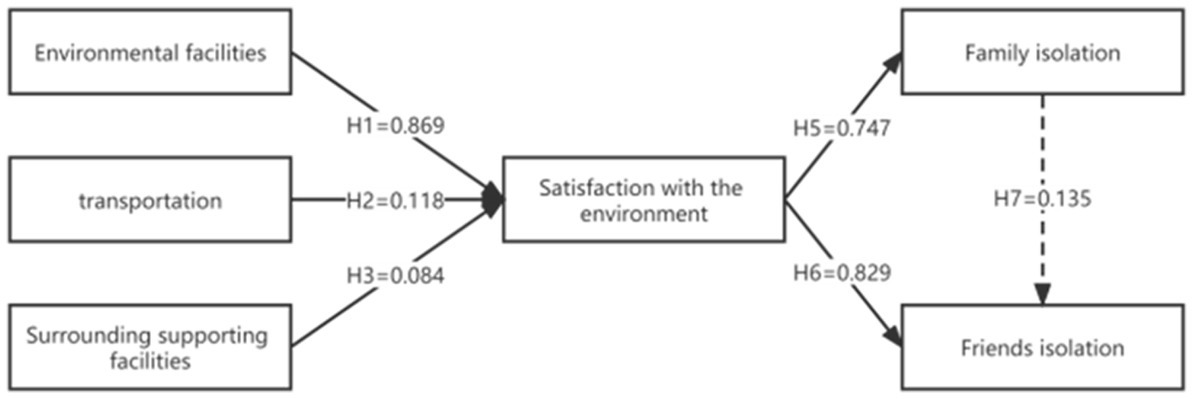
Figure 4. Model path coefficient output plot. Combined with Table 4, it can be concluded that community supporting facilities, traffic travel, and environmental facilities can effectively affect community environmental satisfaction. Community environmental satisfaction can also effectively affect friend isolation and family isolation in the community. However, family isolation cannot directly affect friend isolation, and there is no significant causal relationship between them.
4. Discussion
4.1. Impact analysis of community environmental satisfaction
Community environmental facilities (β = 0.869, p < 0.001), transportation (β = 0.084, p < 0.005), and community supporting facilities (β = 0.118, p < 0.005) positively and directly affected environmental satisfaction and together explained 90.4% of the variance in environmental satisfaction (H1, H2, and H3 were confirmed). That is, community environmental facilities, community supporting facilities, and transportation play an important role in the community environmental satisfaction of the older adult.
Environmental facilities scored highly in the community environment satisfaction of the older adult because the older adult are more inclined to walk and enjoy leisure in their community during their daily activities (36). Good traffic continuity and road comfort are conducive to promoting older adult walking and leisure (37), and cleanliness, an active population, and the environment are important factors affecting walking (38). The community environment and facilities can affect the quality of life of the older adult (39). Community facilities are important because older adult people like to walk for entertainment and travel. Therefore, transportation is more concerned with whether department stores, supermarkets, hospitals, and other supporting areas are within walking distance. Transportation scored lowest in community environment satisfaction. This is because most older adult people are not willing to drive or take public transportation, and hitchhiking is the most popular mode of transportation for older adult people (40).
In conclusion, community environmental facilities play a dominant role in the evaluation of the environmental satisfaction of the older adult in the community. Therefore, in future aging designs, priority should be given to the internal green environment, hard decoration, and facilities.
4.2. Associations between environmental satisfaction and social isolation
Environmental satisfaction directly affected friend isolation (β = 0.829, p < 0.001) and family isolation (β = 0.747, p < 0.001). Therefore, the more satisfied the older adult are with the environment, the less social isolation occurs (H4 and H5 are confirmed). Moreover, environmental satisfaction had a greater effect on friend isolation and a slightly smaller effect on family isolation. Among them, although the environment of some industrial communities is poor, most of the community members are factory workers who are familiar with each other. Therefore, family isolation is more significant, but friend isolation is not obvious. There was no social isolation among the cadre leaders. This is because cadre leaders are generally highly educated and better at communicating with their children, neighbors, and friends, so their social network is strong.
Studies have found that most older adult people in China participate in square dance community entertainment activities, which are in high demand (41); through these social activities, they can effectively inhibit social segregation and improve their happiness index (42). However, scholars have also found that the current urban communities leave nearly half of the older adult individuals isolated (43).
Therefore, to prevent the social isolation of older adult individuals, we should first improve the green landscape environment of the community. Second, to meet the needs of older adult community recreational activities, corresponding facilities should be added. Finally, the continuity of community road traffic and road comfort should be optimized to encourage older adult people to travel outdoors.
4.3. Limitations of the study
There are still some shortcomings in this study. First, all participants in this study were older than 60 years old. Due to the great changes in social networks after retirement, the older adult become a high-incidence group for social isolation. Older adult individuals are the most frequent users of community public spaces. However, other age groups may also face social isolation, so to fully explore the relationship between community environmental satisfaction and social isolation, we should consider further related research on other age groups. Second, due to the limitations of the structural equation model, this study studied only the Xi’an area. However, this research method is applicable to any region. Therefore, this research method should be used for future research and analysis in other regions. Finally, this study primarily focuses on the older adult in urban communities. Since the older adult in rural areas of China primarily live in self-built houses, their lifestyles, life behaviors, and social interactions are quite different from those of the older adult in urban communities of China, so a comparative analysis cannot be carried out. Therefore, the follow-up study can focus on the living habits and environment of the older adult in rural areas of China.
5. Conclusions and suggestions
Starting from the community environment, this study is the first to comprehensively construct a structural equation model of the impact of community environmental satisfaction on the social isolation of older adult individuals.
First, there are significant differences in the focus on the older adult’s environmental satisfaction. Environmental facilities have a much higher impact on environmental satisfaction than transportation and supporting facilities, while transportation has the least impact on environmental satisfaction. Second, the relationship between the community environment and the social isolation of the older adult was revealed; that is, environmental satisfaction had a direct positive effect on social isolation, and the effect of environmental satisfaction on friend isolation was more obvious. The results showed that the older adult paid more attention to the environmental facilities of the community, such as greening, sanitation, equipment, and road paving. Most older adult people do not need to go far away, so they do not care much about the convenience of transportation. Older adult people prefer to have complete facilities around the community, including hospitals, supermarkets, and shopping malls. There is no direct effect of family isolation or friend isolation on older adult individuals, but a clean, comfortable, and well-equipped community can effectively decrease social isolation. This study provides a new idea for the prevention of social isolation and provides data support for the design of aging environments in the future.
Based on the results of this study, three suggestions are proposed for the prevention of social isolation and age-appropriate design. A high-quality community environment and landscape should be provided, diversified activity facilities should be improved, road continuity and comfort should be ensured, and outdoor activities and communication should be promoted for the older adult in the community.
Data availability statement
The raw data supporting the conclusions of this article will be made available by the authors, without undue reservation.
Author contributions
SM, GL, and YD: conceptualization and writing—review and editing. SM: methodology, software, formal analysis, investigation, data curation, and writing—original draft preparation. SM and GL: resources. All authors contributed to the article and approved the submitted version.
Acknowledgments
Thanks to the 210 seniors who participated in the survey, and to GL and YD for their guidance on the paper.
Conflict of interest
The authors declare that the research was conducted in the absence of any commercial or financial relationships that could be construed as a potential conflict of interest.
Publisher’s note
All claims expressed in this article are solely those of the authors and do not necessarily represent those of their affiliated organizations, or those of the publisher, the editors and the reviewers. Any product that may be evaluated in this article, or claim that may be made by its manufacturer, is not guaranteed or endorsed by the publisher.
References
1. National Bureau of Statistics. Bulletin of the Seventh National Population Census. (2021). Available at: http://www.stats.gov.cn/tjsj/sjjd/202105/t20210512_1817336.html.
2. L,, Guo, Q, Liu, S, Wang, H, Cao, J, Liang, X, et al. Research progress on the occurrence and influencing factors of social isolation in the elderly in the community. China Sanat Med. (2022) 9:945–7.
3. Park, RE, and Burgess, EW. Introduction to the science of sociology: including an index to basic sociological concepts. Chicago, IL, USA: University of Chicago Press (1970).
4. Weldrick, R, and Grenier, A. Social isolation in later life: extending the conversation. Can J Aging. (2018) 37:76–83. doi: 10.1017/S071498081700054X
5. Cotterell, N, Buffel, T, and Phillipson, C. Preventing social isolation in older people. Maturitas. (2018) 113:80–4. doi: 10.1016/j.maturitas.2018.04.014
6. Hong, M, Gagne, JCD, and Shin, H. Social networks, health promoting-behavior, and health-related quality of life in older Korean adults. Nurs Health Sci. (2018) 20:79–88. doi: 10.1111/nhs.12390
7. Lu, J, Zhang, N, and Wang, Y. Quality of life among different types of Chinese lonely elderly: a social isolation based analysis. Psychol Health Med. (2022) 27:1357–65. doi: 10.1080/13548506.2021.1883072
8. Bahramnezhad, F, Chalik, R, Bastani, F, Taherpour, M, and Navab, E. The social network among the elderly and its relationship with quality of life. Electron Physician. (2017) 9:4306–11. doi: 10.19082/4306
9. Luo, F, Guo, L, Thapa, A, and Yu, B. Social isolation and depression onset among middle-aged and older adults in China: moderating effects of education and gender differences. J Affect Disord. (2021) 283:71–6. doi: 10.1016/j.jad.2021.01.022
10. Byrne, C, Saville, CWN, Coetzer, R, and Ramsey, R. Stroke survivors experience elevated levels of loneliness: a multi-year analysis of the National Survey for Wales. Arch Clin Neuropsychol. (2022) 37:390–407. doi: 10.1093/arclin/acab046
11. Drinkwater, E, Davies, C, and Spires-Jones, TL. Potential neurobiological links between social isolation and Alzheimer’s disease risk. Eur J Neurosci. (2022) 56:5397–412. doi: 10.1111/ejn.15373
12. Beller, J, and Wagner, A. Loneliness, social isolation, their synergistic interaction, and mortality. Health Psychol. (2018) 37:808–13. doi: 10.1037/hea0000605
13. Cudjoe, TKM, Roth, DL, Szanton, SL, Wolff, JL, Boyd, CM, and Thorpe, RJ. The epidemiology of social isolation: National Health and Aging Trends Study. J Gerontol B. (2020) 75:107–13. doi: 10.1093/geronb/gby037
14. Kotian, DB, Mathews, M, Parsekar, S, Nair, S, Binu, VS, and Subba, SH. Factors associated with social isolation among the older people in India. J Geriatr Psychiatry Neurol. (2018) 31:271–8. doi: 10.1177/0891988718796338
15. Schrempft, S, Jackowska, M, Hamer, M, and Steptoe, A. Associations between social isolation, loneliness, and objective physical activity in older men and women. BMC Public Health. (2019) 19:74. doi: 10.1186/s12889-019-6424-y
16. Barnett, A, Zhang, CJP, Johnston, JM, and Cerin, E. Relationships between the neighborhood environment and depression in older adults: a systematic review and Meta-analysis. Int Psychogeriatr. (2018) 30:1153–76. doi: 10.1017/S104161021700271X
17. Berto, R. The role of nature in coping with psycho-physiological stress: a literature review on restorativeness. Behav Sci. (2014) 4:394–409. doi: 10.3390/bs4040394
18. Toseland, R, and Rasch, J. Factors contributing to older persons’ satisfaction with their communities. Gerontologist. (1978) 18:395–402. doi: 10.1093/geront/18.4.395
19. Schinka, JA, and Greene, RL. Structural equation modeling: basic concepts and applications in personality assessment research. J Pers Assess. (2013):294–317. doi: 10.1207/s15327752jpa6803_4
20. Bureau of Statistics Survey Center of Xi’an and pension status report of the elderly living conditions. Available at: http://tjj.xa.gov.cn/tjsj/tjxx/619e21e3f8fd1c0bdc6da63f.html.
21. Xu, Y, Zhou, D, Qiu, Z, and Li, Z. Research on planning and layout of pension facilities based on spatial distribution characteristics of the elderly population. J Archit. (2017) 9:74–7.
22. Zhou, HY. Research on micro-renovation design of outdoor space in single-type old community based on PSPL investigation method. Chongqing, China: Chongqing University (2019).
23. Lubben, J, Blozik, E, Gillmann, G, Iliffe, S, von Renteln Kruse, W, Beck, JC, et al. Performance of an abbreviated version of the Lubben social network scale among three European community-dwelling older adults populations. Gerontologist. (2006) 46:503–13. doi: 10.1093/geront/46.4.503
24. Dawes, J. Five point vs. eleven point scales: does it make a difference to data characteristics. J Mark Res. (2002):10.
26. Wu, K, Vassileva, J, and Zhao, Y. Understanding users’ intention to switch personal cloud storage services: evidence from the Chinese market. Comput Hum Behav. (2017) 68:300–14. doi: 10.1016/j.chb.2016.11.039
27. Barrett, P. Structural equation modelling: adjudging model fit. Personal Individ Differ. (2007) 42:815–24. doi: 10.1016/j.paid.2006.09.018
28. Mcintosh, CN. Rethinking fit assessment in structural equation modelling: a commentary and elaboration on Barrett. Personal Individ Differ. (2007) 42:859–67. doi: 10.1016/j.paid.2006.09.020
29. Loehlin, JC. Latent variable models: an introduction to factor, path, and structural equation analysis: fourth edition In: J Educ Stat, vol. 12 (2004). 410. doi: 10.2307/1165058
30. Wu, M. Structural equation model: Practical advance of AMOS. Chongqing, China: Chongqing University Press (2013).
32. Hayduk, LA. Structural equation modeling with LISREL In: Essentials and advances. Baltimore, MD, USA: JHU Press (1987).
33. Bagozzi, RP, and Yi, Y. On the evaluation of structural equation models. J Acad Mark Sci. (1988) 16:74–94. doi: 10.1007/BF02723327
34. Hu, L, and Bentler, PM. Fit indices in covariance structure modeling: sensitivity to underparameterized model misspecification. Psychol Methods. (1998) 3:453. doi: 10.1037/1082-989X.3.4.424
35. Scott, JE. The measurement of information systems effectiveness: evaluating a measuring instrument. ACM SIGMIS Database: Database Adv Inf Syst. (1995) 26:43–61. doi: 10.1145/206476.206484
36. Kim, HS, and Park, S. Elderly needs in community facilities within residential areas-comparing the differences between metropolitan cities, small and medium-size cities, and rural areas. J Archit Inst Korea. (2022) 38:15–24. doi: 10.5659/JAIK.2022.38.5.15
37. Wu, Z-J, Song, Y, Wang, H-L, Zhang, F, Li, F-H, and Wang, Z-Y. Influence of the built environment of Nanjing’s Urban Community on the leisure physical activity of the elderly: an empirical study. BMC Public Health. (2019) 19:1459. doi: 10.1186/s12889-019-7643-y
38. Borst, HC, Miedema, HME, de Vries, SI, Graham, JMA, and van Dongen, JEF. Relationships between street characteristics and perceived attractiveness for walking reported by elderly people. J Environ Psychol. (2008) 28:353–61. doi: 10.1016/j.jenvp.2008.02.010
39. Hao, J., and Zhang, J. The impact of community care service system on the quality life of the elderly. In Proceedings of the 2018 2nd International Conference on Social Sciences, Arts and Humanities (SSAH 2018), Tianjin, China, (2018), 9–10.
40. Kim, S. Transportation alternatives of the elderly after driving cessation. Transp Res Rec J Transp Res Board. (2011) 2265:170–6. doi: 10.3141/2265-19
41. Wu, J. Conception of strategic cooperation between universities and community elderly service centers. SHS Web Conf. (2022) 145:01014. doi: 10.1051/shsconf/202214501014
42. Giebel, C, Hassan, S, Harvey, G, Devitt, C, Harper, L, and Simmill-Binning, C. Enabling middle-aged and older adults accessing community services to reduce social isolation: community connectors. Heal Soc Care Community. (2020) 30:e461–8. doi: 10.1111/hsc.13228
Keywords: community, satisfaction with the environment, the older adult, optimal aging, social isolation
Citation: Ma S, Lou G and Duan Y (2023) Prevention of the social isolation of older persons: the impact of community environmental satisfaction on social isolation. Front. Public Health. 11:1177483. doi: 10.3389/fpubh.2023.1177483
Edited by:
Narelle Warren, Monash University, AustraliaReviewed by:
Carlo Lazzari, South West Yorkshire Partnership NHS Foundation Trust, United KingdomNuelle Novik, University of Regina, Canada
Copyright © 2023 Ma, Lou and Duan. This is an open-access article distributed under the terms of the Creative Commons Attribution License (CC BY). The use, distribution or reproduction in other forums is permitted, provided the original author(s) and the copyright owner(s) are credited and that the original publication in this journal is cited, in accordance with accepted academic practice. No use, distribution or reproduction is permitted which does not comply with these terms.
*Correspondence: Gang Lou, bG91Z2FuZzczQG53YWZ1LmVkdS5jbg==
 Sen Ma
Sen Ma Gang Lou1*
Gang Lou1*